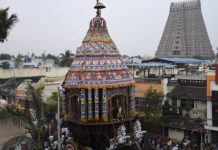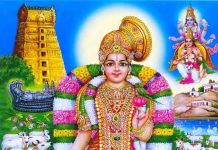Published from “Three Minutes” series written by A.S.Rajagopalan Swami of Ohio.
nin paDikku ellAm tan paDi
ERka
anbuDan ninnODu avadarittu
aruLi
(Swami Desikan, mummanikkovai)
svAmi deshikan lucidly injected the main concepts from the veda-s into a small tamizh hymn called mummaNikkOvai. The ten word verse given above gives the best description of the role of shrI with respect to Lord shrIman nArAyaNan. nammAzhvAr declared shrI as one, “who never leaves the Lord” (agalagillEn iRaiyum yenRu alarmEl mangai) in his tiruvAimozhi. Following his footsteps, deshika extends that further, here. “shrI is the one who takes the nature, form, character and ownership (svarUpa, rUpa, guNa, vibhUti) that is in His taste and in harmony with Him. She is yearning to make descents (avatAra-s) along with Him to bless everyone.”
At least ten meanings can be derived about shrI: from the above verse of 10 words
1. Infinite descents - Her descents are infinite just like His;
2. Conformity of form - Her forms (rUpam) conform (ERpa) with His.
3. Compatibility of nature - Her innate nature (svarUpa) is compatible with His
4. Inseparability - She is always with Him
5. Affectionate to Him - She is so affectionate towards Him
6. Suitable to him in all aspects - She is suitable to Him in every aspect
7. Loves everyone and everything - She always accompanies Him in every descent because of Her motherly love
8. Pours out Her grace - She blesses through her descents.
9. Synchronizes with the Lord - She synchronizes Her descent with His
10. Keeps in mind - She remembers (put them down in memory) to grace at proper time
The word choices here are so astonishing. Each word lends to multiple meanings. For example, nin paDikku ellAm tan paDi - Here paDi has eight meanings – stepping stone, body, accordingly, nature, earth, read, stuck, fall down. nin paDi has eight and tan paDi has eight and if one starts deriving the viable combination of meanings, there is no end. The multitude of meanings in this verse is like inserting an universe inside an atom (aNuvukkuL aNDattai nuzaittARpOl).
The nature, role, power, of lakShmI, has been debated for ages among several traditions. According to deshika’s tradition (sampradAyam), lakShmI is a supreme soul (paratvam) and pervasive everywhere (vibhutvam). Yet, scripts confirm unilaterally that there is only one supreme soul; there is no second supreme ever. deshika himself has condemned the idea of fusion of two souls or the splitting of a soul, stating that both are meaningless and incompatible with scripts. So, how do we accommodate both nArAyaNa and lakShmI? The ever-combined gemini form (midhunam) of nArAyaNan and lakShmI is the ultimate. The divya dampati as shriya: pati is the para tattvam. Sage ParAshara, in his shrI ViShNu PurANam, says that the Lord is one soul who took male qualities as nArAyaNan and personifies the female qualities as lakShmI.
Just like a coin must have both a head and tails or a piece of paper must have a front and back, you can’t have nArAyaNan without lakShmI. VyAsa bhagavAn says in shrimad bhAgavatam that shrI appears with Lord all the time (anapAyini bhagavatI shrI: sAkShAt Atmano hareH 12-11-10). When the scripts and AzhvAr-s mention of nArAyaNa alone, shrI is implicitly included, as svAmi rAmAnuja said (emperumAnai solliya iDamellAm avaLaiyum solliRRAm AyiRRE). So, there is only one supreme soul, shriman nArAyaNan and lakShmI, countless individual souls (jIvAtma, cetana, cit) and non sentient (acit, acetanam) things make up the basic triple reality (tattva trayam).
Sage ParAsara also says “lakShmI! When He came down as rAma, you came as sItA. When He came down as KR^iShNa, You came as RukmiNI; whatever angle of form He takes, so do You. When He takes human form, so do You. You are always inseparable (nityaiva eShA viShNoH shrIH anapAyinI … jaganmAtA). Such a long saMskR^it shloka, has been reduced to a mere 10 words here. deshika also implicitly points out that tamizh scripts have the most condensed form of expressing our tradition. mummaNikkOvai is the essence of the elaborate shrImad rahasya traya sAram, just like the AzhvAr’s 4000 verses (nAlAyira divya prabhandam) is the essence of all samskR^it holy scripts (veda-s).
Let us see an example. Let’s say your father is a judge. You call him “father” at home and call him as “Judge” in the court. Here, the same person takes on multiple names but that is just the social custom. When you say, Oh judge, my father - it is redundant. But you say it that way to make it clear for everyone. So whether you say nArAyaNa or shrI, it refers the other and vice versa. After all, it is the same soul that you referring to. I have simplified the position of shrI according to deshika tradition. Other traditions and individuals may have different views and we respect their views. Our purpose is not to defend a position, but rather to follow and pass on our tradition.
What my mother cooks is good for me and what your mother cooks may be good for you.
What we learn –
1. Only one Supreme soul (Ishvara tattva) exists. It is the shriyaH pati, combined nArAyaNan and shrI forms.
2. Whenever nArAyaNan is mentioned, shrI is mentioned implicitly.
3. shrI is inseparable from nArAyaNan by space (desha), time (kAla), or state (avastha).
4. shrI form is brimming with motherly qualities like kindness(dayA), compassion (vAtsalyam), patience (kShamA), recommendation (puruShakAratvam).
5. nArAyana form represents fatherly qualities - ownership (svAmitvam), independence (svAtandriam), judiciary (daNDakaratvam) etc.
6. Why do they have certain split qualities like that? Well, it is their family affair, and we should not question that.
What’s in a name? That which we call a rose By any other name would smell as sweet;





